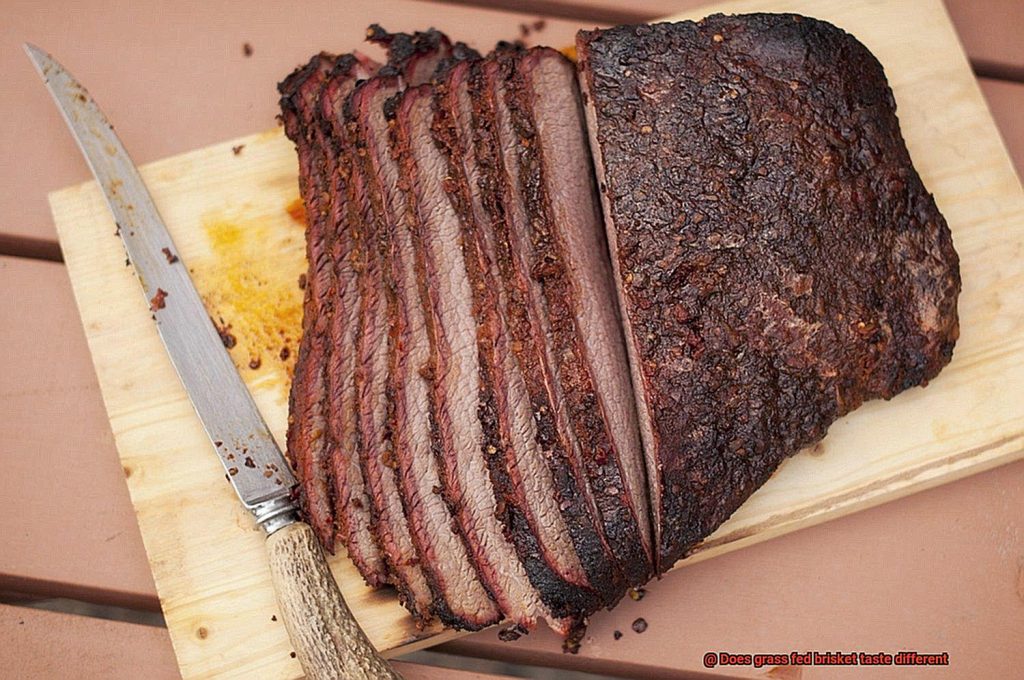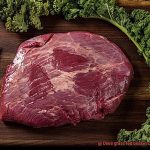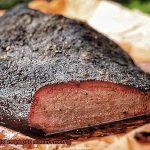Today, we’re diving into a sizzling topic that has left foodies pondering: “Does grass-fed brisket taste different?” Get ready, because we’re about to explore the seasoned world of beef and uncover the truth behind this culinary conundrum.
When it comes to brisket, most of us know it as a mouthwatering BBQ staple. But now, amidst the growing interest in sustainable and natural food practices, grass-fed beef has become a buzzword in gastronomic circles. And rightfully so.
Traditionally, brisket comes from cows that graze on grass pastures. However, nowadays, the majority of beef is grain-finished—cows are fed a mix of grains for faster growth. So here’s the question: does the dietary difference affect the taste?
Some argue that grass-fed brisket boasts a more robust flavor profile. The cattle’s natural diet of varied grasses gives the meat a rich, earthy, and slightly “gamey” experience. On the other hand, grain-finished brisket tends to be milder with a buttery and creamy texture.
But wait—flavors aren’t the only factors at play here. Grass-fed advocates highlight potential health benefits too: it’s leaner, lower in fat content overall, and higher in omega-3 fatty acids, vitamin E, and antioxidants compared to grain-fed counterparts.
While taste and nutrition are undoubtedly fascinating aspects to consider, let’s not forget personal preferences and cooking techniques. The debates surrounding grass-fed versus regular brisket grilling techniques and seasonings can’t be ignored.
In this blog series, we’ll take a closer look at both sides of the sizzling coin—diving into science, culture, and anecdotes that surround this debate. We’ll interview experts, share secret tips, and even venture into the world of recipes and flavor pairings. So whether you’re a serious brisket connoisseur or just a curious carnivore, stay tuned.
We’re on a mission to satisfy your palate while unraveling the mystery behind grass-fed brisket’s taste and culinary allure. It’s time to put your apron on, grab your meat thermometer, and join us as we embark on this delicious journey.
Contents
What is Grass Fed Brisket?
Prepare your taste buds for an extraordinary culinary adventure with the succulent and flavorful masterpiece known as grass-fed brisket. This delectable cut of beef originates from cows that have been exclusively nourished on a natural diet of grasses and forages throughout their lives. Beyond its distinctive earthy flavor, grass-fed brisket boasts a leaner texture that will take your grilling experience to unprecedented heights.
Delightful Cooking Tips for Grass-Fed Brisket:
- Master the art of cooking: Given its lower fat content, grass-fed brisket can dry out if not handled with care. To preserve its moisture and tenderness, opt for moist cooking methods such as slow cooking or braising. This ensures that every bite remains juicy and tender.
- Unlock the essence of flavor: Elevate the already delightful taste of grass-fed brisket by marinating it overnight. Infuse the meat with additional layers of flavor using a simple combination of olive oil, garlic, herbs, and spices. Each mouthwatering bite will burst with an explosion of deliciousness.
- Patience is key: Remember, slow and steady wins the race when it comes to cooking grass-fed brisket. Low and slow is the mantra. Allowing the meat to tenderize gradually results in melt-in-your-mouth perfection that will leave you craving more.
- Let it rest: Once you’ve perfectly grilled your grass-fed brisket, grant it some well-deserved rest before slicing into it. This essential step allows the juices to redistribute throughout the meat, ensuring every slice is juicy and brimming with flavor.
- Unleash your creativity: The natural flavors of grass-fed brisket harmonize seamlessly with a variety of rubs and seasonings. From tantalizing BBQ spice rubs to herb-infused blends, let your imagination roam free and uncover your very own signature flavor profile.
How Does Grass Fed Brisket Taste Different from Grain-Fed?
Step into the world of grass-fed and grain-fed brisket, where taste and texture collide to create a mouthwatering experience like no other. In this blog post, we’ll delve into the differences between grass-fed and grain-fed brisket, exploring their flavor profiles, textures, nutritional value, and more. Get ready to tantalize your taste buds and unleash your inner grill master.
The Diet Difference:
- Grass-Fed Brisket: Cattle raised on a natural diet of grass and forage, resulting in leaner meat with distinct flavors.
- Grain-Fed Brisket: Cattle fed a diet that includes grains like corn and soy, leading to a milder taste and softer texture.
Flavor Profile:
- Grass-Fed Brisket: Prepare yourself for an explosion of flavors. Grass-fed brisket boasts a leaner fat content with natural marbling, resulting in a rich, earthy taste. The unique combination of grass and forage in the diet adds an herbaceous note, giving it a wild game-like essence that will leave you craving more.
- Grain-Fed Brisket: If you prefer a milder taste with a hint of sweetness, grain-fed brisket is your go-to choice. The grains in the cattle’s diet contribute to a more neutral flavor profile, allowing the natural beef taste to shine through.
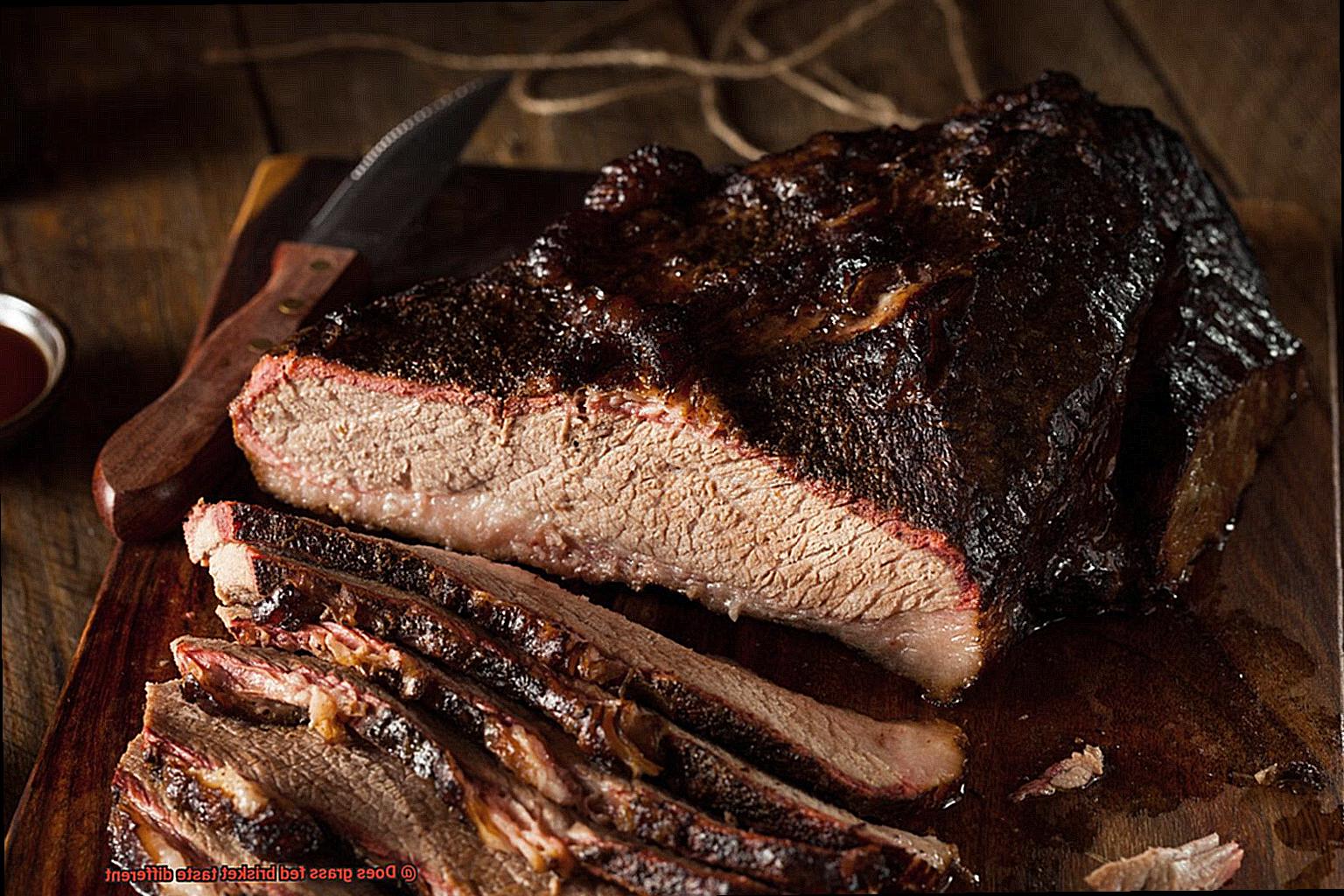
Texture:
- Grass-Fed Brisket: Brace yourself for a firm texture that offers a satisfying chew. While grass-fed brisket may be slightly tougher than its grain-fed counterpart, fear not. Proper cooking techniques will reward you with tender and juicy meat that melts in your mouth.
- Grain-Fed Brisket: Indulge in the melt-in-your-mouth goodness that grain-fed brisket offers. The extra marbled fat content creates a softer texture, making each bite an experience of pure delight.
Nutritional Value:
- Grass-Fed Brisket: Looking for a healthier option? Grass-fed brisket is known to have higher levels of omega-3 fatty acids, vitamins, and minerals due to the varied diet of the cattle.
- Grain-Fed Brisket: While grain-fed brisket may have lower omega-3 fatty acids, it still provides essential nutrients and is often more readily available.
Factors that Influence the Flavor of Grass Fed Brisket
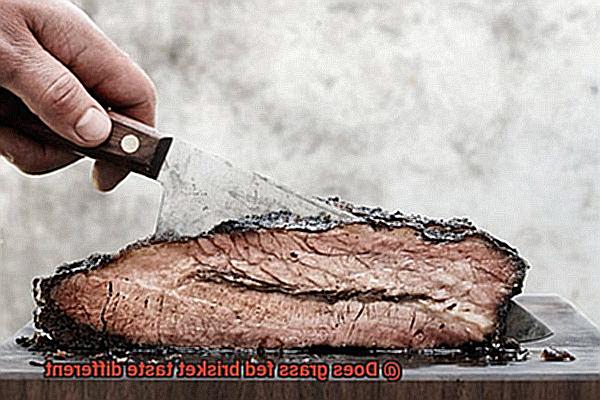
Embark on a tantalizing journey through the world of brisket and discover the factors that influence the flavor of grass-fed bliss. Whether you’re a seasoned grill master or just starting out, understanding these factors will take your culinary adventures to a whole new level. So grab your apron and let’s dive in.
First up on our flavor expedition is the animal’s diet. Grass-fed brisket comes from cattle nourished primarily on grass and other forage. This leaner meat has a distinct flavor profile compared to conventionally raised cattle, which are often fed grains and concentrates. The grassy goodness shines through in every succulent bite.
But it’s not just any grass that plays a role in the flavor of grass-fed brisket. The specific types of grasses the cattle consume can make all the difference. Different grass species have varying levels of nutrients and flavors, which can be transferred to the meat. Imagine grazing on pastures rich in clover or alfalfa – it’s like adding a touch of sweetness to your brisket.
Now let’s talk seasonal variation. Just like our taste buds change with the seasons, so does the flavor of grass-fed brisket. During different times of the year, the composition and taste of grass can vary, subtly altering the flavor of the meat. Think springtime with its vibrant, herbaceous taste versus winter months when the diet is primarily composed of dry hay.
Exercise is also a key player in the flavor game. Grass-fed cattle have more freedom to roam and engage in natural behaviors, including regular exercise. This increased activity level contributes to more muscular and well-toned meat. Picture those well-exercised brisket muscles – firm texture, richer flavor – it’s like a workout for your taste buds.
Last but not least, let’s not forget about age. The age at which the animal is harvested plays a role in determining the flavor of grass-fed brisket. Younger animals tend to have more tender meat with a milder flavor, while older animals bring a stronger, more pronounced taste to the table. The age of the animal can also affect the marbling, or fat distribution, in the meat, impacting both texture and flavor.
Pros and Cons of Eating Grass Fed Brisket
Then, it’s time to dive into the world of grass-fed brisket. This flavorful cut of meat is gaining popularity for its unique taste and potential health benefits. But before you fire up the grill, let’s explore the pros and cons of eating grass-fed brisket.
Let’s start with the pros. One of the biggest advantages of grass-fed brisket is its rich and complex flavor. The natural grass diet of the cattle gives the meat a unique taste that is often described as more natural and earthy. If you’re tired of the same old flavor profiles, then grass-fed brisket is sure to tantalize your taste buds.
Another pro is that grass-fed brisket tends to be leaner than its grain-fed counterpart. This makes it a great option for those who are conscious about their fat intake or following a specific dietary plan. While the lower fat content may make the meat slightly less tender, proper cooking techniques can easily offset this.
Health-conscious individuals will also appreciate that grass-fed beef is generally considered healthier than grain-fed beef. It boasts higher levels of beneficial omega-3 fatty acids and conjugated linoleic acid (CLA), which have been linked to improved heart health and immune function. Plus, grass-fed brisket is typically free from hormones, antibiotics, and other artificial additives commonly found in conventional beef production.
However, like any good piece of meat, grass-fed brisket does have its cons. The first drawback is that it can be more expensive than grain-fed brisket. The production process for grass-fed beef requires more time, space, and resources, which ultimately contributes to the higher price tag. But many people are willing to pay the premium for the perceived quality and health benefits.
Another con to consider is that grass-fed brisket may require slightly different cooking methods compared to grain-fed brisket. Due to its lower fat content, it’s important to cook grass-fed brisket at a lower temperature and for a shorter period of time to prevent it from becoming dry or tough. This can be a challenge for those who are not familiar with cooking grass-fed meat or prefer the convenience of traditional cooking methods.
Lastly, some individuals may find the taste of grass-fed brisket too strong or gamey compared to conventionally raised beef. The distinctive flavor profile of grass-fed meat may not appeal to everyone’s palate, and personal taste preferences play a role in determining whether grass-fed brisket is a pro or con.
Tips for Cooking Grass Fed Brisket
Cooking grass-fed brisket requires special attention due to its leaner nature. In this article, we will explore essential tips to ensure your grass-fed brisket turns out tender, flavorful, and absolutely delicious.
Marinating for Moisture:
To enhance the natural flavors and add moisture to grass-fed brisket, marinating is key. Create a delicious marinade using olive oil, garlic, and your choice of herbs and spices. Let the brisket soak in this mouthwatering concoction for at least a few hours or overnight to infuse it with goodness.
Slow and Low Cooking:
Grass-fed brisket benefits from slow and low cooking to break down tough fibers and retain moisture. Set your grill or smoker to a lower temperature (around 250°F) and cook the brisket for a longer period. This gentle cooking method ensures the meat becomes tender, juicy, and full of flavor.
Use a Meat Thermometer:
Grass-fed brisket cooks faster than grain-fed due to its lower fat content. To prevent overcooking, use a meat thermometer to monitor the internal temperature. Aim for medium-rare or medium doneness for the juiciest results.
Resting for Tenderness:
After cooking, let your grass-fed brisket rest for at least 15-20 minutes before slicing. This resting period allows the juices to redistribute evenly throughout the meat, ensuring each bite is tender and succulent.
Slice Against the Grain:
When slicing your cooked grass-fed brisket, remember to cut against the grain. This means slicing perpendicular to the direction of the muscle fibers. Cutting against the grain helps break up tough muscle fibers, resulting in melt-in-your-mouth tenderness.
Recipes to Try with Grass Fed Brisket
Look no further. With its rich and distinct flavor, grass fed brisket is a meat lover’s dream. But how can you take it to the next level? By trying out different marinades, rubs, and seasonings, of course. Let’s explore some recipes that will have your taste buds begging for more.
First up, we have the classic slow-cooked barbecue brisket. Marinate the meat in a flavorful rub or marinade, then cook it low and slow over indirect heat. This allows the flavors to penetrate the meat, resulting in a juicy and tender brisket that will leave you wanting seconds.
If you’re feeling adventurous, why not braise your grass fed brisket? Sear the meat on all sides to develop a rich crust, then cook it in a liquid like broth or wine over low heat. This method infuses the meat with flavor and keeps it moist, resulting in a melt-in-your-mouth texture that is simply irresistible.
For those who like it hot, try spicy preparations like chili or spicy beef tacos. The robust flavor of grass fed brisket pairs perfectly with bold spices, creating a dish that will satisfy your cravings.
If you’re watching your waistline but still want to enjoy the deliciousness of grass fed brisket, fear not. Thinly slice the meat and use it in salads or sandwiches for a hearty and flavorful element without the guilt.
Don’t be afraid to experiment with different marinades, rubs, and seasonings. Garlic, rosemary, and black pepper are just a few examples that can bring out the natural flavors of grass fed brisket.
Substitutes for Grass Fed Brisket
Fear not. In this guide, we’ll explore some delectable substitutes that will still deliver a mouthwatering and satisfying meal. Whether you’re a grilling enthusiast or simply looking for an alternative, these options are sure to tantalize your taste buds.
Conventional Grain-Fed Beef:
While it may lack the distinct flavor of grass-fed beef, conventional grain-fed beef is an easily accessible and budget-friendly substitute. Though slightly fattier and milder in taste, when cooked with finesse, it can still result in tender and flavorful dishes that will impress your guests.
Chuck Roast or Short Ribs:
For those seeking a different cut with comparable tenderness, chuck roast or short ribs are excellent alternatives to brisket. Slow-cooked to perfection, these cuts transform into succulent and flavorful delights that will satisfy even the most discerning meat lovers.
Pork Shoulder or Pork Butt:
If you’re open to non-beef options, look no further than pork shoulder or pork butt as substitutes for brisket. Renowned for their tender meat and rich flavors, these cuts shine when cooked low and slow. Prepare pulled pork from these cuts, and you’ll have a delicious alternative that rivals the finest brisket.
Chicken Thighs or Drumsticks:
For those yearning for a leaner option, chicken is a fantastic substitute for brisket. While it may not possess the same depth of flavor as beef, chicken can still be utterly delightful when seasoned and cooked with finesse. Explore the realms of smoked or grilled chicken thighs or drumsticks for a lighter yet deeply satisfying meat option.
Health Benefits of Eating Grass Fed Brisket
Look no further than grass-fed brisket. In this article, we will delve into the world of mouthwatering grass-fed beef and explore its remarkable impact on your well-being. So, fire up your grill and get ready to savor a nutritious and flavorful meal.
Nutrient-Dense Meat:
Grass-fed brisket stands out for its superior nutrient content. Unlike conventionally raised beef, grass-fed cattle graze on natural grasses and other forage, resulting in meat that is densely packed with essential vitamins, minerals, and antioxidants. Indulging in grass-fed brisket ensures that you’re nourishing your body with an abundance of vital nutrients.
Heart Health:
Bid farewell to unhealthy saturated fats. Grass-fed brisket is lower in total fat content, particularly the detrimental saturated fats that contribute to heart diseases. By opting for grass-fed beef, you are making a heart-smart choice while still relishing a juicy and flavorful meal.
Omega-3 Fatty Acids:
Boost your brain health and combat inflammation with the elevated levels of beneficial omega-3 fatty acids found in grass-fed brisket. Research has linked omega-3s to a reduced risk of chronic diseases such as heart disease and cancer, making grass-fed beef an intelligent choice for your overall well-being.
Antioxidant Powerhouse:
Prepare to fortify your body’s defenses with grass-fed beef’s richness in antioxidants like vitamin E and beta-carotene. These potent compounds shield your body from free radicals and oxidative stress, promoting better overall health and reducing the risk of chronic inflammation.
Conjugated Linoleic Acid (CLA):
Grass-fed brisket boasts higher levels of CLA, a compound that possesses anti-cancer properties and aids in weight management by promoting fat loss and increasing lean muscle mass. By savoring grass-fed beef, you are nourishing your body while potentially reducing the risk of cancer and supporting a healthy weight.
No Hormones or Antibiotics:
When you choose grass-fed brisket, you are opting for meat that is free from added hormones and antibiotics commonly used in conventional farming practices. This ensures that you can enjoy your meal without any potential exposure to these substances, providing peace of mind for your health-conscious lifestyle.
Essential Nutrients:
Grass-fed beef, including brisket, serves as a substantial source of essential nutrients such as iron, zinc, and B vitamins. These nutrients play a vital role in energy production, immune function, and maintaining healthy blood cells. By incorporating grass-fed brisket into your diet, you are nourishing your body with vital nutrients that promote optimal well-being.
1EgdykV0Ug0″ >
Conclusion
The conclusion is clear: grass-fed brisket does indeed taste different.
The natural diet of grass gives the meat a distinct flavor profile that sets it apart from conventionally raised brisket. It’s like comparing a fresh, crisp apple to one that has been sitting in storage for weeks.
The grass-fed brisket is juicier, more tender, and has a richer, more complex taste. It’s like a symphony of flavors dancing on your palate.
So, if you’re looking for a truly exceptional dining experience, opt for grass-fed brisket.

